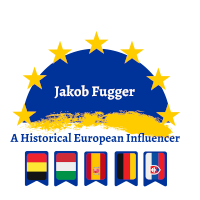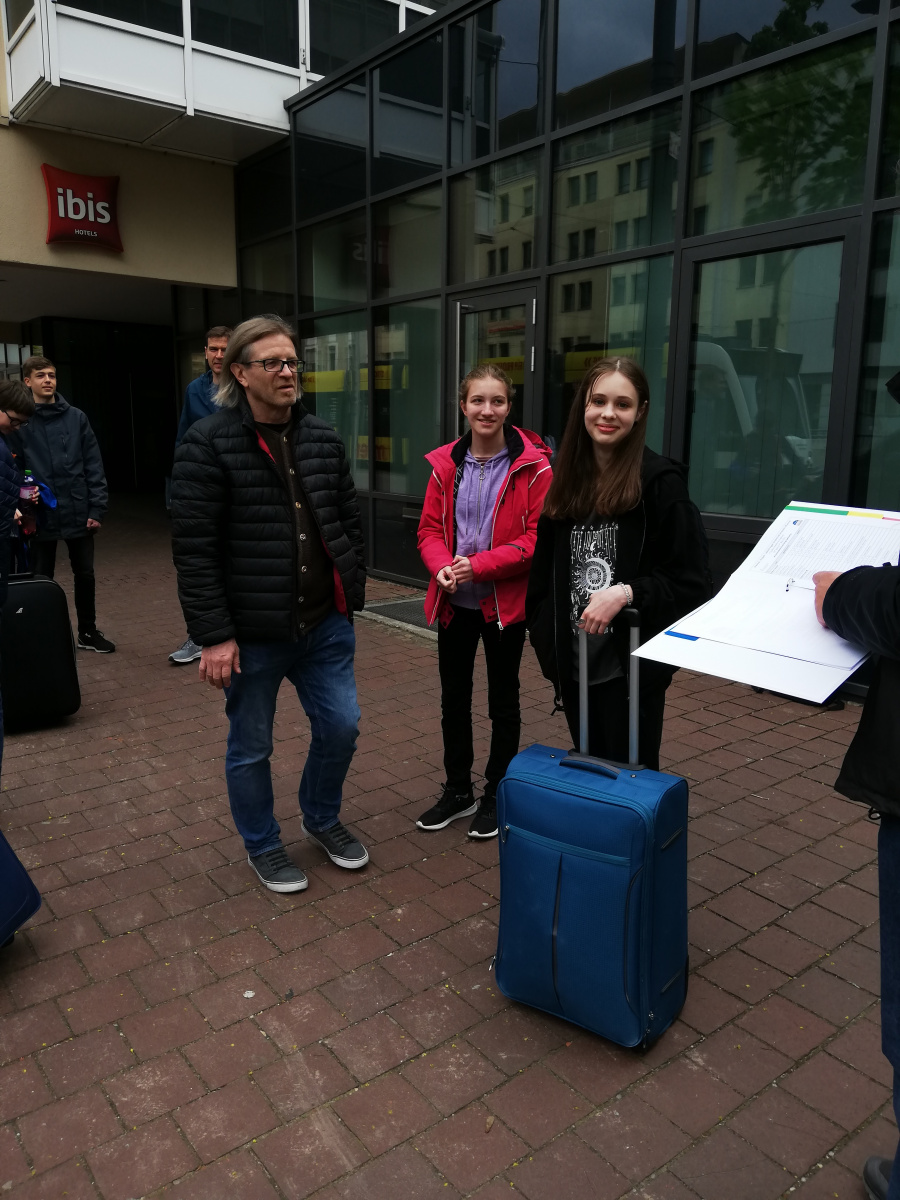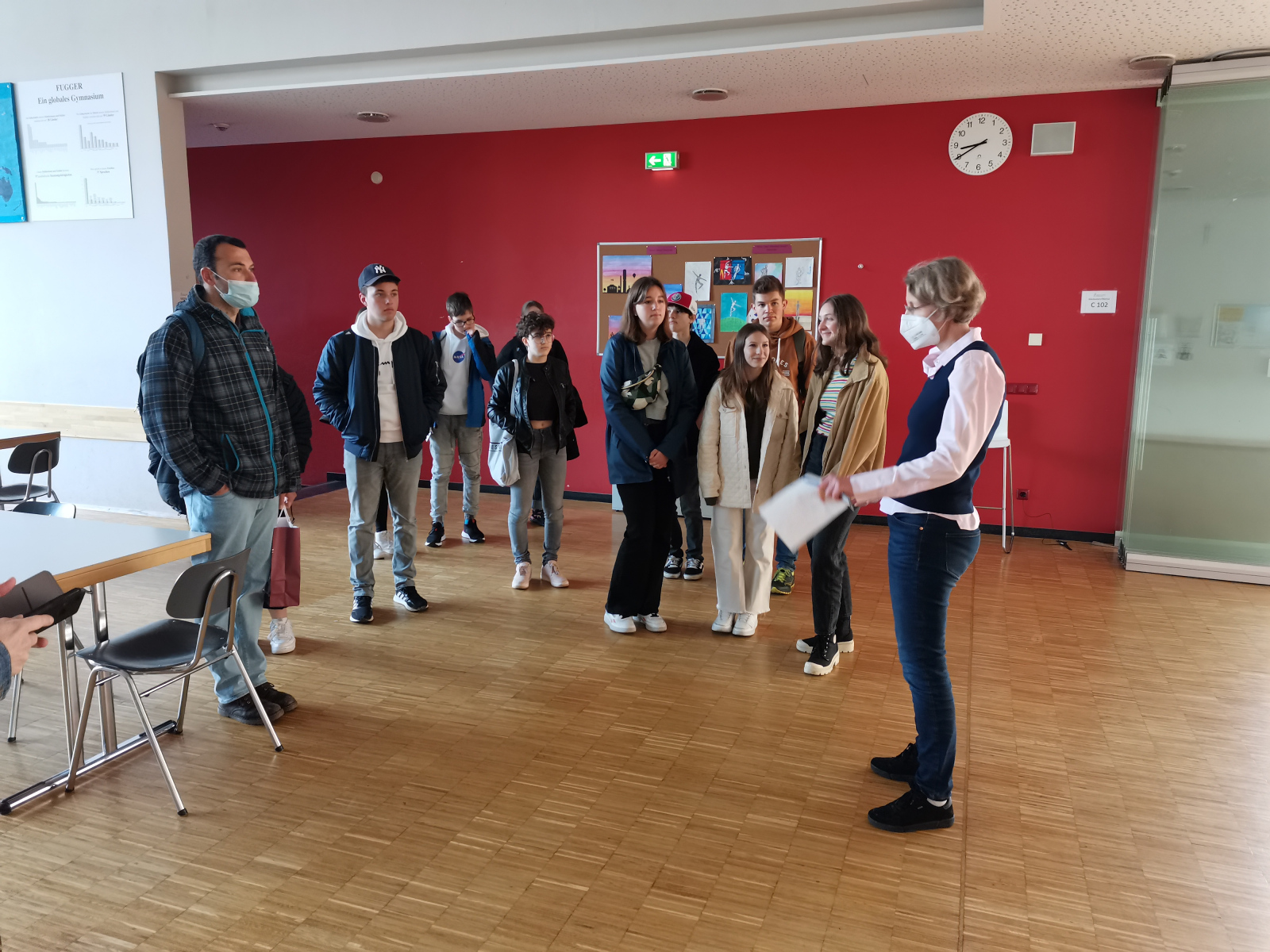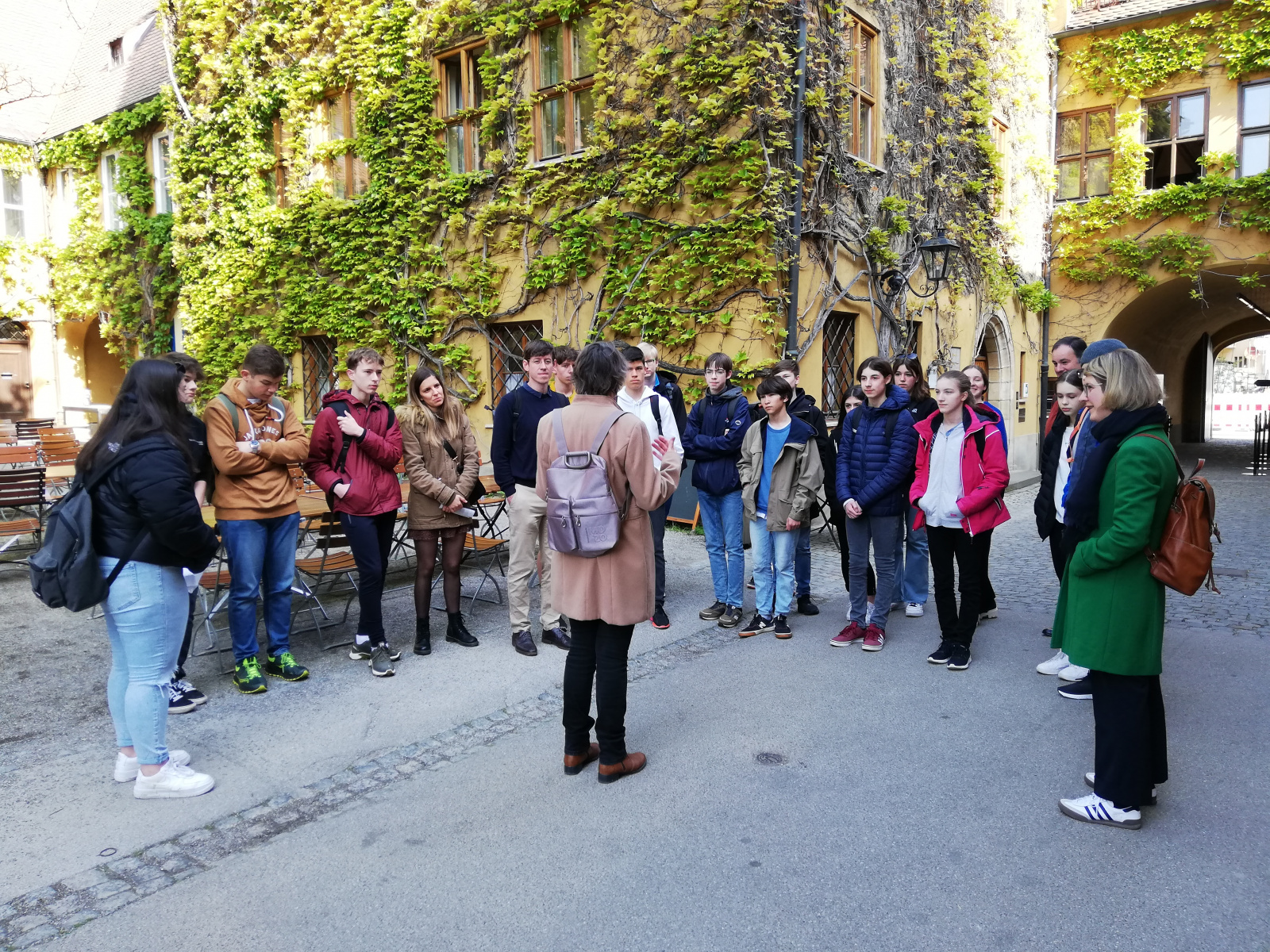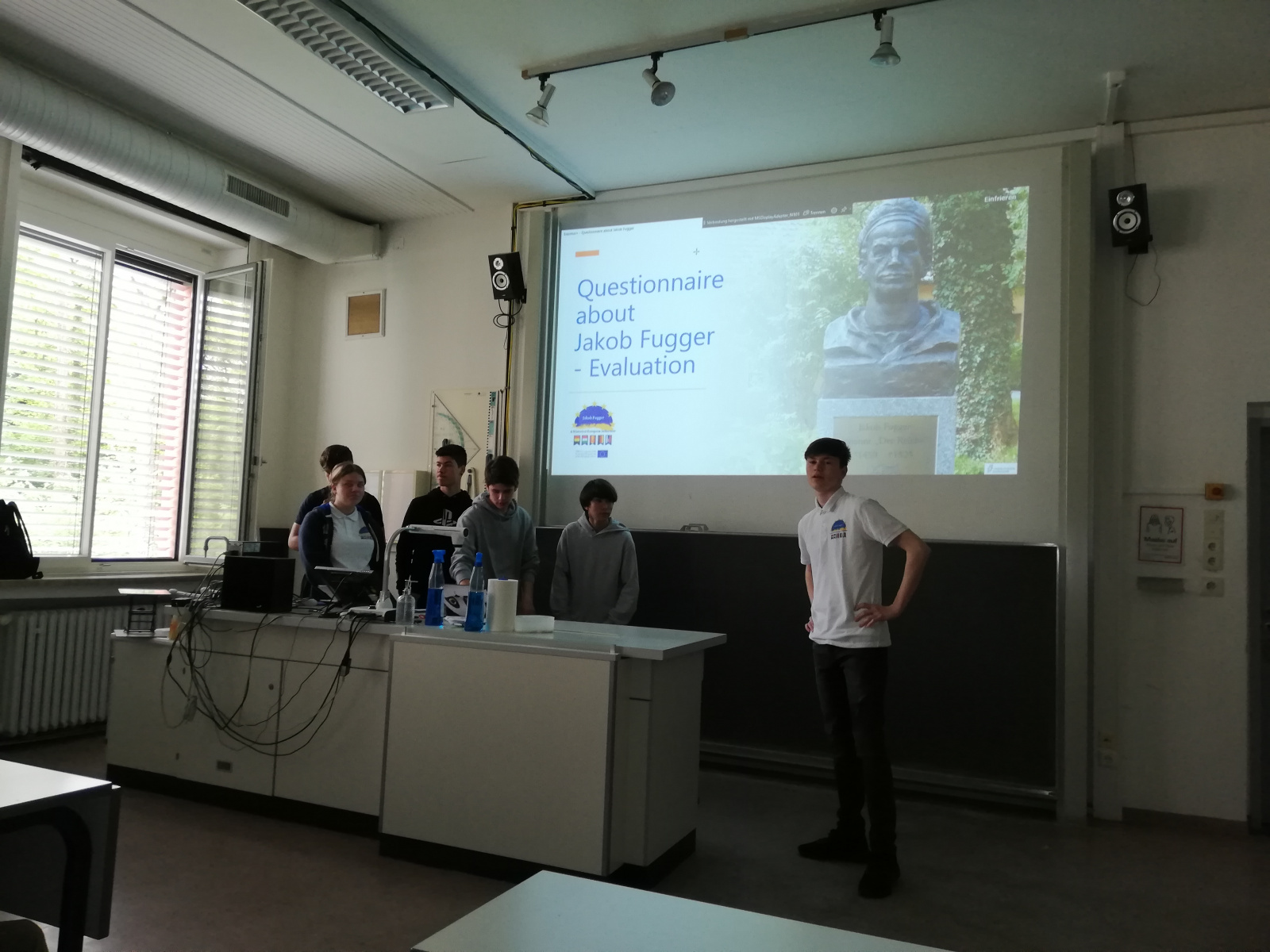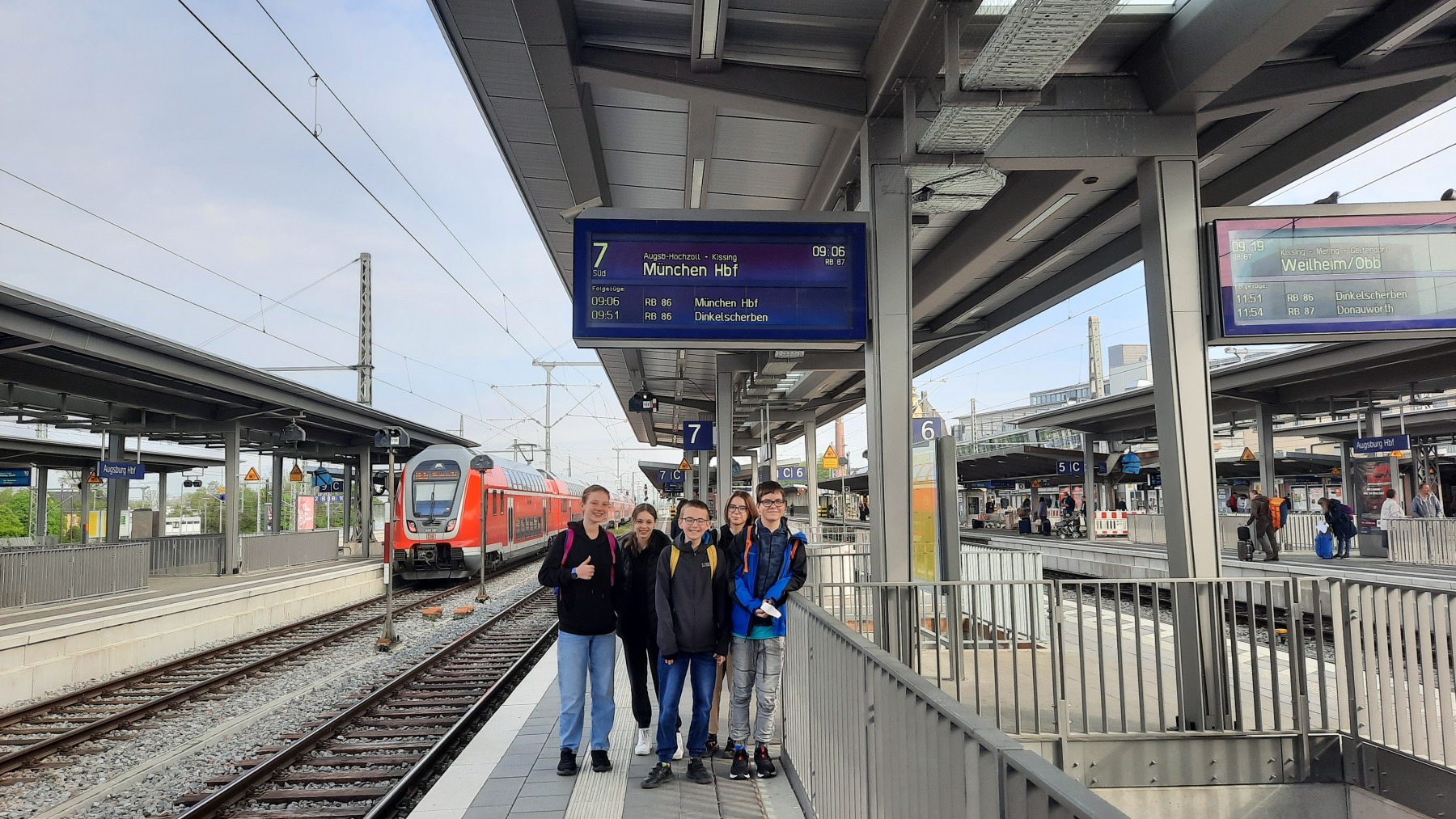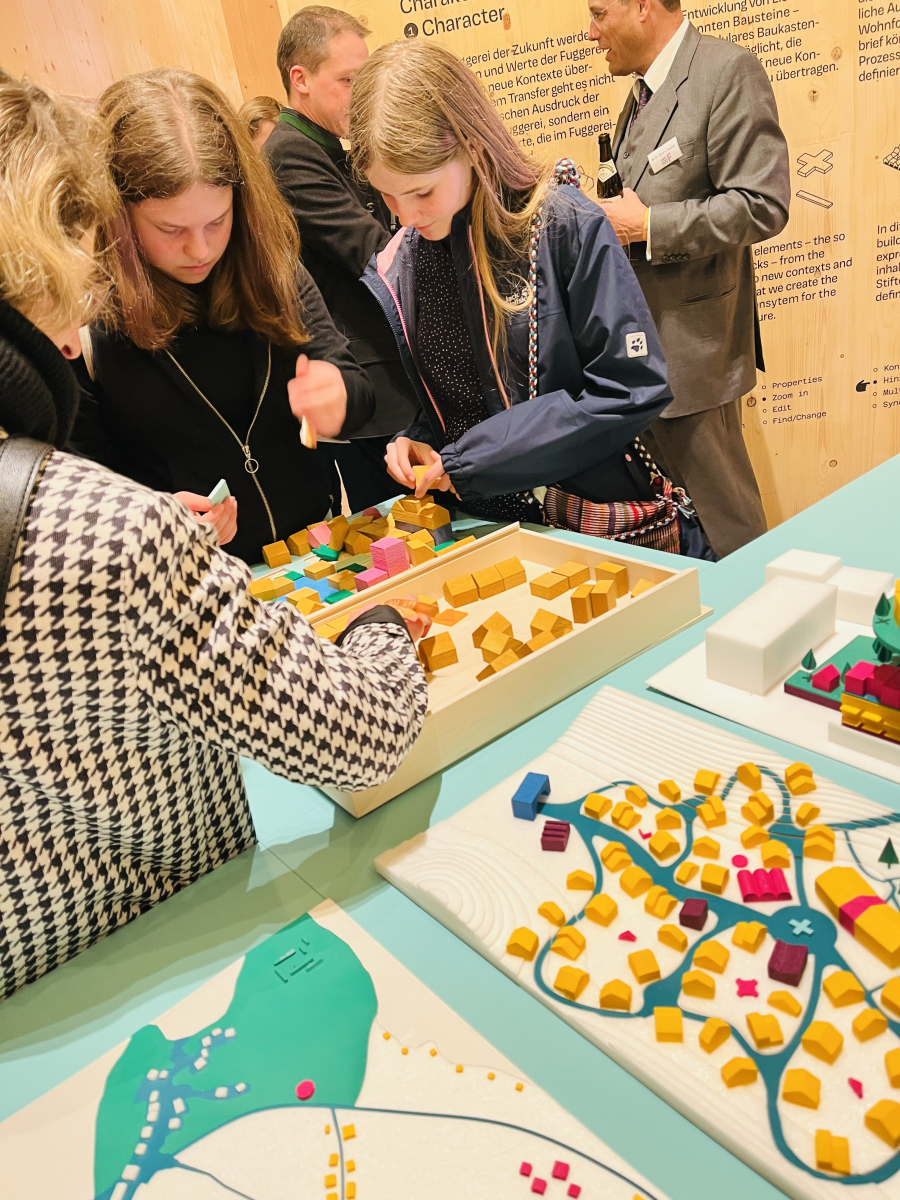On 30th of April, the time had finally come. After more than a year and a half of waiting due to Corona, the students from the partner schools from Belgium, Spain, Slovakia and Italy finally arrived in Augsburg for the kick-off project week as part of the Erasmus+ project. After being welcomed by the German host students and their families, all project participants met for the Welcome Dinner. Waiting for the food then also offered the first opportunity to get into conversation and thus make new and unique friendships.
The “Family Day” was scheduled for Sunday and offered the families the opportunity to spend a little more time with their guests and get to know them better. Fortunately, a traditional German folk festival, the “Plärrer”, was taking place in Augsburg at this time, so it was a great opportunity for the families and guests to visit this festival. Other families took their guests to breath-taking places in the area around Augsburg where they could experience beautiful landscapes, small, picturesque towns and unique nature.
Monday started at the JFG with the official welcome by the headmistress and a school tour. Afterwards, the guests took part in some lessons to experience the everyday life of the German pupils. After lunch in the school canteen, everyone met in the school garden for the obligatory group photo. A short time later, the scavenger hunt was opened at the Augustus Fountain. The students were able to discover Augsburg in a whole new way by filling in fun and interesting quiz questions about famous people and sights in Augsburg. Most of the scavenger hunt took place in the old part of Augsburg. This was a good way to show the exchange students the history of the city on the spot. After the rally and working through the quiz questions, everyone met at the Ulrichskirche and decided to go to the Citygalerie, the largest shopping centre of Augsburg to explore. Back in the JFG’s school garden, preparations for dinner were already underway. While the students enjoyed various sports and games, such as football, badminton and many other fun activities, the traditional Bavarian dinner was prepared by the caretaker family. After dinner, everyone helped to clean up the school garden again and so the very successful first programme day of this project week came to an end.
“Time flies when you’re having fun,” Albert Einstein once said, and that certainly applies to the Erasmus project week. The first few days were already over when it was finally time on Tuesday to explore one of the most important sights founded by Jakob Fugger: The Fuggerei – the oldest social settlement in the world. The Erasmus group was split into two groups and after a short introduction, both groups went on a journey through the history of the Fuggerei and learned everything from the first idea to build the Fuggerei, to its destruction during the Second World War and its reconstruction after the war. Not only the history of this special place is very interesting, but also its current structural condition. Interesting for all pupils and teachers was the fact that the rent has remained the same since the foundation of the Fuggerei: it has always been one Rhenish guilder (today 88 cents) – plus three prayers a day for the Fugger family.
Now it was time to apply the knowledge they had acquired. The students now had the opportunity to explore the Fuggerei by themselves and answer some questions about the residents, life in the social housing complex and moreover, how this very special place functions and is managed in the first place. Divided into new smaller multinational groups, the elaboration could begin. Trying to answer all the questions, the students visited the “Museum of the Residents” and the “Museum of Everyday Life”. They had to find out what was special about the concept of the Fuggerei and were able to listen to the experiences of former and current residents. At the end, the students had the opportunity to write down what they like about the place and what they would change. One of the biggest concerns was, of course, having to pay to get home late, as the gates of the Fuggerei close after 10pm!
After the lunch break, a visit to the Fugger-Welser Erlebnis Museum was on the agenda. Here the pupils could learn a lot of things about the influence of the Fugger and Welser families up to the present day. In the workshops at the museum, the pupils became aware that the earlier European view of other countries and the whole world is in some ways still present today. This was illustrated by means of a “real world map” which, in contrast to the colonial view, shows that Europe is not the centre of the world as it is depicted on the “usual” maps. In addition, other central problems such as discrimination against certain groups were on the agenda, because the Middle Ages were also a time of slavery. There was a large slave market in which the Fugger family was also involved.
To illustrate how many people still face discrimination or discriminatory situations today, all participants had to do a small exercise called “If this applies to you, move”. In this way, the group found out who has experienced discrimination. After discussing the topic from a postcolonial and historical perspective, the workshop participants discovered new ways of “changing perspectives” on discrimination and acceptance. This also opened up a new dimension of how Jakob Fugger left his mark. The last task of the day was to find a word or a short sentence that sums up all the knowledge and perspectives gained. Many wonderful ideas were presented, and the day ended with a good feeling and great hopes for the future.
It was the fifth day of the programme. At school, all the country groups presented their results of the questionnaire about Jakob Fugger, which had been conducted before the mobility in the respective countries. It was about questions like “Should there be a Fuggerei 2.0?”, “Who would finance it?”, “Who should live there?” and “What should it look like?”. During the presentation, Kahoot was played and a video of the live survey from Slovakia was shown, in which the students asked passers-by what they knew about Jakob Fugger and associated with his name. The results of the questionnaires in the countries were very different.
Afterwards, the official reception of the city of Augsburg with the deputy mayor, Martina Wild, was on the agenda. She took the project group on a short journey through the history of Augsburg and particularly emphasised how important European projects like ours are in these times. The logical next step was to visit the “Golden Hall” in the town hall, one floor higher. Wonderful photos were taken of this amazing room, from which one can also enjoy a very beautiful view over Augsburg.
After a short lunch break, the programme included an interview with a descendant of Jakob Fugger, Maria Theresia Countess Fugger von Glött, in the Fuggerei. The questions, such as “What is it like to be a member of the Fugger family?”, “What do you do for a living?”, “Is everyone in your family rich?” or “Where is all the Fugger family money now?” were worked out by the pupils in advance and uploaded online. Afterwards, there was still plenty of time for spontaneous questions.
Afterwards, free time and recreation was again the order of the day, which some spent shopping or simply strolling around. The square in front of the town hall was so impressive for everyone that many photos were taken, which were then also immediately posted on social media, so that the students who stayed at home also received a small update every now and then.
At the end of the day there was another highlight, a visit to a bowling centre. The colours and music there were fantastic and there was a really nice atmosphere. All students had a lot of fun bowling more or less successfully in multinational groups.
Since the project members had seen many important places in Augsburg so far and learned a lot about Jakob Fugger in Europe, the visit to the state capital Munich was on the agenda for Thursday. After a short train journey, the two city guides were already waiting at Marienplatz. There was a lot to learn about the kings, the merchants and also the most important churches of the city. The tour ended at the Viktualienmarkt, just in time for lunch.
Back in Augsburg, another special event was on the agenda in the auditorium of the Jakob Fugger Gymnasium: the Fugger Forum on Jakob Fugger. Astrid Gabler, Head of Communications and Programmes of the Princely and Count Fugger Foundation, who spoke about “The Fugger Foundations and the Future of a Unique Idea” and Katharina Dehner M.A., Deputy Director of the Fugger and Welser Museum, who reported on “The European Fugger Road – One Company, Many Perspectives” were the keynote speakers of the evening before the pupils of the participating countries presented their connection to Jakob Fugger and his traces in the different countries. All in all, the students as well as the teachers of the JFG, who were also invited, the parents as well as the interested public enjoyed the evening and learned a lot of new things about Jakob Fugger and his traces in Spain, Italy, Belgium and Slovakia. As the forum was broadcasted on the internet for the first time via livestream with over 250 participants, all students, parents and teachers in the different project countries were able to follow the event in real time.
On the morning of 6 May, we visited the Fugger forests near Laugna, where we were given a guided tour by the forestry manager of the “Fürstlich und Gräflich Fuggersche Stiftungen”. Apart from ecological questions, such as how to make the forest resistant to climate change and how one must now look about 100 years into the future when planting new trees, the main focus was also on the economic aspect. The yield of this forest has to finance the Fuggerei, among other things. The participants were also given answers to questions about felling and reforestation, the use of machinery and the forest as a CO2 reservoir. Afterwards, it was back to the school, where a late breakfast with typical Bavaria “Weißwurst” was waiting before the evaluation of the project week began.
At 7 p.m., the farewell party started in the historic cellar of the Philisteria Mercatura – the fraternity of the Jakob Fugger Gymnasium – in the city centre, to which all families brought food, resulting in a considerable buffet. The evening ended with loud Spanish music and dancing in the cellar before heading back to the town hall square at around 10pm. As one of the first groups after the invited guests of honour, the Erasmus+ project group was allowed to visit the Fuggerei NEXT500 pavilion. The wooden pavilion, which was built to celebrate the 500th anniversary of the Fuggerei, offered information about the Fuggerei as well as interactive stations where visitors could build their own little Fuggerei of the future with building blocks or computer animation. In the café and bar area, the pupils met many important politicians from Bavaria as well as members of the Fugger family they already knew. A band played music. It was a nice event. This last joint activity was also the highlight of the project week and so after the visit of the pavillion it was time for the sometimes tearful farewells. See you again in Sterzing, Almadén, Antwerp or Banská Bystrica…
